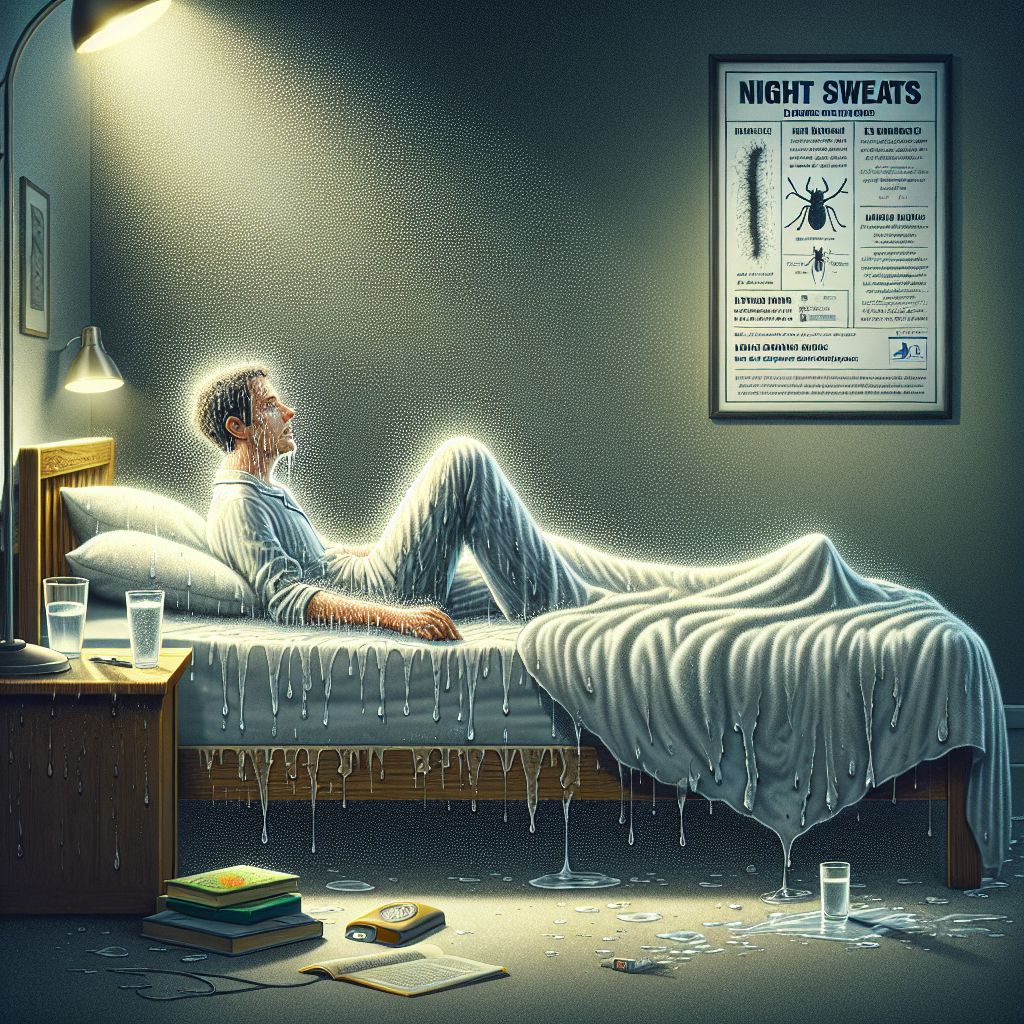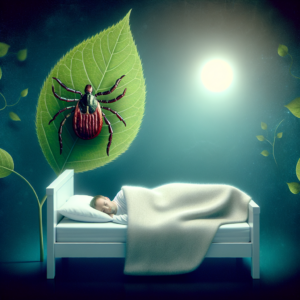-
Lyme disease symptoms can be subtle and often mimic other conditions.
-
Night sweats are a lesser-known symptom of Lyme disease that may be easily overlooked.
-
Recognizing early symptoms like night sweats can lead to earlier diagnosis and treatment.
-
Understanding the difference between chronic and acute Lyme symptoms is critical.
-
Seeking medical advice when symptoms persist or worsen is crucial for proper management.

The Stealthy Nature of Lyme Disease
Over the decades, I’ve seen many patients walk through my clinic doors with a myriad of symptoms, some clear and some as elusive as a whisper in the wind. Lyme disease, caused by the bacterium Borrelia burgdorferi, transmitted through the bite of an infected tick, often falls into the latter category. The reason? Its symptoms can be as stealthy as the ticks themselves, often masquerading as other illnesses and leaving sufferers in a haze of confusion and misdiagnosis.
Why Lyme Disease Symptoms Are Easily Overlooked
One of the primary reasons Lyme disease symptoms go unnoticed is their chameleon-like nature. Early signs such as fatigue, joint pain, and fever are non-specific and can easily be attributed to more common viral illnesses. It’s not until more distinct symptoms emerge, like the characteristic bull’s-eye rash, that Lyme disease enters the differential diagnosis. However, not everyone with Lyme disease gets this rash, and that’s where the trouble begins.
Chronic vs. Acute Symptoms: Understanding the Difference
When we talk about Lyme disease, it’s important to distinguish between acute and chronic manifestations. Acute symptoms appear soon after the tick bite and may include fever, rash, facial paralysis, and arthritis. Chronic Lyme disease, on the other hand, refers to symptoms that persist for months or even years after the initial infection, often because it was not identified or treated early on. Chronic symptoms can be more debilitating and significantly harder to treat.
The Role of Misdiagnosis in Delayed Lyme Disease Recognition
Often, patients with Lyme disease are initially misdiagnosed with conditions like fibromyalgia, chronic fatigue syndrome, or even depression. This misdirection can lead to years of incorrect treatment and prolonged suffering. Therefore, a keen eye and a deep understanding of Lyme’s subtleties are essential for early detection and management.
Identifying Subtle Lyme Disease Symptoms
As a family doctor, my role is to piece together the puzzle of symptoms that may easily be dismissed as trivial or unrelated. It’s these minor signs that, if caught early, can lead to a timely Lyme disease diagnosis and a better outcome for my patients.
Night Sweats: An Unexpected Symptom
One symptom that often flies under the radar is night sweats. These episodes of excessive sweating during sleep are not just uncomfortable; they can be a sign of the body’s fight against an infection like Lyme disease. Night sweats in the context of Lyme are thought to be due to the body’s immune response trying to eliminate the bacteria.
Minor Aches and Pains: Not Just “Getting Older”
Another set of symptoms that can be easily brushed off are minor aches and pains. Many of my patients initially attribute these to aging or overexertion. However, when these pains are persistent, migratory, and not tied to any specific injury, it’s worth considering Lyme disease, especially if the patient has a history of tick exposure.
Fatigue and Brain Fog: More Than Just Being Tired
Fatigue is another common complaint that can have countless causes. But when a patient describes a level of exhaustion that’s not relieved by rest, or a type of cognitive impairment they refer to as ‘brain fog,’ I start to consider Lyme disease, especially in the absence of other clear explanations.
Seeking Medical Advice: What to Do When Symptoms Worsen
If you or a loved one are experiencing persistent or worsening symptoms that don’t seem to fit a clear pattern, it’s important to seek medical advice. As a family doctor, I’ve learned that when symptoms like night sweats, joint pain, or unexplained fatigue become more frequent or severe, it’s a signal that the body is struggling with something more than just the wear and tear of daily life.
“Remember, you know your body better than anyone else. If something feels off, don’t hesitate to seek medical attention. Early intervention can make a significant difference in the management of Lyme disease.”
When visiting your doctor, be as detailed as possible about your symptoms. Note the frequency, intensity, and any triggers you may have observed. Mention any tick bites or time spent in areas known for Lyme disease. Your detailed account can be the key to a correct diagnosis.
Post-Treatment Revelations: The Retrospective Clues
Many patients who finally receive treatment for Lyme disease often experience an ‘aha’ moment when they realize that symptoms they had previously ignored were actually signs of their condition. For instance, the resolution of night sweats and a marked improvement in energy levels can be a retrospective confirmation of Lyme disease.
These post-treatment Lyme disease symptoms are important. They not only validate the patient’s experiences but also highlight the subtlety of Lyme disease symptoms. As a family doctor, I emphasize the importance of looking back at these symptoms to better understand the full scope of the disease. I also personally recommend a longer course of treatment when these so called Post Lyme symptoms are present. I think most of them are undetreated for chronic lyme disease.
It’s through these insights that we can learn and improve our ability to detect Lyme disease early on.
Improvement of Unrecognized Symptoms After Treatment
As treatment for Lyme disease begins to take effect, many patients report a significant improvement in symptoms that they hadn’t even realized were related to the disease. This includes the resolution of night sweats, a decrease in joint pain, and a clearer mind. These improvements serve as a testament to the body’s ability to heal once the underlying infection is addressed.
Connecting Past Symptoms to Lyme Disease Diagnosis
Looking back, patients often recognize that what they thought were disparate health issues were actually connected as part of Lyme disease. This realization underscores the importance of considering Lyme disease in the differential diagnosis when patients present with a constellation of nonspecific symptoms.
Learning From Retrospective Diagnosis to Prevent Future Cases
Understanding the symptoms that were overlooked or misattributed in the past can help us prevent future cases of unrecognized Lyme disease. It’s a learning process for both doctors and patients alike, highlighting the need for thorough investigation of unexplained symptoms, especially in Lyme-endemic areas.
Night Sweats and Lyme Disease: An Underreported Symptom
Night sweats are a particularly perplexing symptom of Lyme disease that don’t get as much attention as they should. While night sweats can have various causes, when they occur in the context of Lyme disease, they can be a sign of the body’s immune response to the infection.
Understanding the Physiological Cause of Night Sweats in Lyme Disease
The physiological cause of night sweats in Lyme disease is not entirely understood, but it’s believed to be related to the body’s attempt to fight off the infection. The immune response triggered by the presence of Borrelia burgdorferi bacteria can cause fluctuations in body temperature, leading to sweating.
Documented Cases and Research Insights
Research into Lyme disease has documented night sweats as a symptom experienced by some patients. However, more research is needed to fully understand this phenomenon and its implications for diagnosis and treatment.
How to Monitor and Manage Night Sweats at Home
If you’re experiencing night sweats, it’s important to monitor the frequency and severity of these episodes. Keeping a symptom diary can be helpful in identifying patterns and potential triggers. To manage night sweats at home, consider the following tips:
-
Maintain a cool, comfortable sleeping environment.
-
Use breathable bedding and sleepwear.
-
Stay hydrated throughout the day.
-
Avoid spicy foods and caffeine close to bedtime, as they can exacerbate sweating.
The Need for Increased Lyme Disease Awareness
One of the most effective ways to combat the misdiagnosis and underrecognition of Lyme disease is through increased awareness and education.
Education on Lyme Disease Symptoms for the General Public
It’s essential for the general public to be informed about the wide range of symptoms associated with Lyme disease, including those that are less commonly recognized like night sweats. Awareness campaigns can help spread this knowledge, especially in areas where Lyme disease is prevalent.
By empowering individuals with knowledge about Lyme disease symptoms and the importance of early detection, we can improve outcomes for those affected. As someone who has dedicated their career to caring for patients of all ages, I know firsthand the difference that awareness and education can make.
The Need for Increased Lyme Disease Awareness
One of the most effective ways to combat the misdiagnosis and underrecognition of Lyme disease is through increased awareness and education.
Key Takeaways
-
Lyme disease symptoms can be subtle and often mimic other conditions.
-
Night sweats are a lesser-known symptom of Lyme disease that may be easily overlooked.
-
Recognizing early symptoms like night sweats can lead to earlier diagnosis and treatment.
-
Understanding the difference between chronic and acute Lyme symptoms is critical.
-
Seeking medical advice when symptoms persist or worsen is crucial for proper management.
FAQ: Commonly Asked Questions About Unrecognized Lyme Disease
As we wrap up our discussion on Lyme disease, let’s address some common questions that arise when considering this often-misunderstood illness.
Can Lyme Disease Really Be Unrecognized for Years?
Yes, Lyme disease can go unrecognized for years. This is particularly true when the initial symptoms are mild or when they mimic other common illnesses. Without the hallmark rash or a clear history of a tick bite, diagnosis can be challenging. This underscores the importance of thorough medical evaluation when symptoms are persistent.
What Are the Most Commonly Overlooked Symptoms of Lyme Disease?
The most commonly overlooked symptoms of Lyme disease include:
-
Intermittent joint pain and swelling
-
Mild, recurring headaches
-
Unexplained fatigue that doesn’t improve with rest
-
Night sweats and chills
-
Neurocognitive issues, such as difficulty concentrating or memory lapses
How Can Night Sweats Be Distinguished from Other Causes?
Night sweats can be caused by various conditions, including infections, hormonal imbalances, and certain medications. To distinguish night sweats caused by Lyme disease from other causes, consider the following factors:
-
Have you had any known tick exposures or spent time in Lyme-endemic areas?
-
Are the night sweats accompanied by other symptoms like joint pain or fatigue?
-
Have you noticed any other unusual or recurring symptoms?
Discussing these factors with your healthcare provider can help determine the cause of your night sweats.
What Should I Do If I Suspect I Have Had Lyme Disease Symptoms for a Long Time?
If you suspect you have had Lyme disease symptoms for a long time, it’s important to:
-
Schedule an appointment with your healthcare provider to discuss your symptoms and concerns.
-
Consider seeking a second opinion from a specialist if you feel your symptoms have not been adequately addressed.
-
Keep a detailed record of your symptoms, including when they started and how they have progressed over time.
-
Signs and Symptoms of Untreated Lyme Disease
Fever, chills, headache, fatigue, muscle and joint aches, and swollen lymph node…
13 Signs and Symptoms of Lyme Disease
Sep 27, 2017 — Sleep disturbances are common with Lyme, including night sweats a…
THE UNDERDIAGNOSIS OF NEUROPSYCHIATRIC LYME …
by BA Fallon · 1998 · Cited by 97 — Common neuropsychiatric symptoms include hea…


Leave a Reply